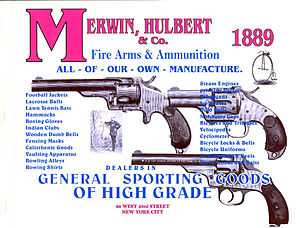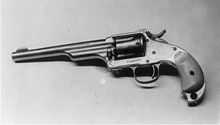Merwin Hulbert

Merwin, Hulbert, and Co. or Merwin Hulbert was an American firearms designer and marketer based in New York City which produced revolvers and rifles from 1876 through 1916. The firearms were manufactured by a subsidiary company, Hopkins & Allen of Norwich, Connecticut.[1] Merwin Hulbert's designs had influenced other gunmakers of the time, such as Meriden Firearms Co., Harrington & Richardson, Forehand & Wadsworth, and Iver Johnson.[2]
During the late 19th century, Merwin Hulbert revolvers were used by police departments of many cities in the eastern United States.[3]
History
Joseph Merwin was involved with marketing revolvers as early as 1856 and first formed an arms company known as Merwin & Bray. This company was folded by 1874. In 1876 Merwin formed a partnership with the William and Milan Hulbert, who owned 50% interest in Hopkins & Allen. Merwin and Hulbert not only designed firewarms, but imported firearms, and retailed firearms and other goods in a large sporting goods endeavor. Merwin and Hulbert additionally purchased several firearms manufacturers. Author Art Phelps poses that if Merwin and Hulbert had not marked the revolvers with the manufacturers name 'Hopkins and Allen' (known for inexpensive and poor quality weapons), the Merwin Hulbert would be as well known as Colt, Smith and Wesson, and Remington. Perhaps, but the company struggled through hardships unrelated to marketing. Payment for three sizable shipments to Russia were never realized. The bankruptcy of subsidiary Evan's Rifle Company cost Merwin and Hulbert $100,000. A company associated literally stole the firms operating capital and disappeared. During 1880-1881, Merwin and Hulbert was in receivership, though it was able to recover. Perhaps the 'hard luck kid' of the arms world, Merwin and Hulbert got a lot of hard breaks. [4]
After Merwin's death in 1888, the company became known as "Hulbert Brothers & Company". Hulbert Brothers declared bankruptcy in 1894 and in 1896 it was liquidated. Hopkins & Allen continued to manufacture Merwin Hulbert marked guns until 1916 when it went bankrupt and was bought the following year by Marlin Firearms.[3]
21st Century revival
In 2010 it was announced that the name of the company had been purchased as well as all of the designs and patents by Gun maker Michael Blank. Blank plans to reintroduce the revolvers made on modern machinery with modern materials.[5] In 2012, the revived Merwin Hulbert company was bought by Sharps Rifle Company, Inc. Potential buyers were encouraged to send in deposits. None of those potential buyers ever received a firearm nor did any of them get their money back. Broadsword Group, the purchaser of Sharps Rifle Company, announced on their website their commitment to return deposits of those who pre-ordered and the discontinuation of any further involvement in the production of Merwin Hulbert revolvers, though they did indicate they are seeking to sell the design to a company that already specializes in reproduction firearms.
Models
Merwin Hulbert manufactured both single action and double action revolvers. Merwin Hulbert's innovation was a rotating barrel design which allowed the user to rotate the barrel 90 degrees in order to pull the barrel and cylinder forward to remove the fired cartridge cases.[6][7] The Merwin Hulbert revolvers were considered to be the strongest made revolvers during the time period in which they were made by Arthur Corbin Gould.[8] During the twisting motion, vacuum literally sucked the empty cases out. Any intact cartridge would remain in the chamber due to the additional length of the bullet. In edition to this unique case extraction system, pressing an additional lever control when the frame was 'open' for extraction allowed the owner to completely remove the barrel. Note - early models also required pushing out a barrel wedge similar in function to Colt percussion revolvers. This not only facilitated cleaning, but allowed the owner to swap barrels, allowing for a shorter 'concealed carry' and longer 'field' weapon in one. The combination of extraction and barrel removal required incredibly tight manufacturing tolerances, that are incredible considering the tools of the day. These revolvers were truly the 'Cadillac' of their day, and collector's prices reflect this.
Frontier Model
The Frontier Model was created to compete with the Colt Model 1873 Single-Action Army (aka Peacemaker), Remington Model 1875, and Smith & Wesson Model 3 as a large frame, big bore six-shooter. Beginning in 1876, the Frontier was produced in four variations. All featured what we consider a 'conventional' trigger and guard. Most were produced in a nickle finish.
1st Model - The first model is single action, identified by it's 'open top' design (no top strap over cylinder), 'scoop' flutes on the cylinder, and a barrel wedge to engage the enclosed cylinder pin. Standard barrel was 7 inches including an integral front sight. Most were manufactured with hard rubber grips - though wood, pearl or ivory could be had for additional cost. The first caliber offered was the proprietary .44 Merwin & Hulbert (.44-30), which resembles the S&W .44 American, but is longer overall. Eyeing the lucrative contracts the Smith and Wesson enjoyed with Imperialist Russia, this model was later produced in .44 Russian.[9] Production began in 1876, and likely ended in or around 1878 with the introduction of the 2nd model.
2nd Model - Very similar to the 1st Model, the second model sported a shorted cylinder locking bolt. This eliminated the need for internal access via a side plate, which was eliminated. The trigger guard was made longer and deeper. Hunting for US Government contracts, there was the addition of a detent pin in the barrel release lever (recommended by the US Ordinance Department). The introduction of caliber .44-40 Winchester (aka Winchester 1873) was an attempt to capture the market of those who preferred the same cartridge for rifle and revolver, acknowledging the popularity of the Winchester rifles of the day. The revolvers in this caliber where engraved with 'Calibre Winchester 1873'. The .44-40 became by far the most popular caliber for the Frontier throughout the remainder of the series. Production of the 2nd model lasted from 1878 to 1882. [10]
3rd Model - Retaining the general look of its predecessors, the 3rd model had significant changes. The first was the addition of a top strap over the cylinder, which added to the strength of the design. The same mechanism for extracting cartridges was retained. The barrel wedge was eliminated as an unnecessary feature. The scoop flutes were replaced with the more common 3/4 length flutes for a slight weight savings. The 3rd model could be had in either single-action or double action. A folding hammer spur was available for those who wished to avoid snagging clothing while drawing the weapon. The 3rd model was produced between 1883 and 1887. [11]
4th Model - The fourth and final model of Frontier began production in 1887. The primary changes from the 3rd model was the addition of a rib atop the barrel. For the first time, the front site was a separate component from the barrel, held by a retaining pin. For the first time, the Frontier was offered with barrel lengths of 3 1/2 or 5 1/2 inches in addition to the 'traditional' 7 inch length. Multiple barrels could be purchased and easily swapped out by the owner without tools. [12]
Pocket Army

The Pocket Arm had three variants starting with the '2nd Model'. Yes, there is no '1st model'. Author Art Phelps established the nomenclature for the Merwin and Hulbert revolver variants, and since the features of the 1st Pocket Army closely aligned to the '2nd Model' Frontier, '2nd Model Pocket Army' was used. This has since become the accepted convention. The Pocket Army featured six cylinders like the Frontier model, and was produced in .44 M&H, .44 Russian, and by far the most popular .44-40 Winchester caliber.
2nd Model - With similar features to the 2nd Model Frontier, the 2nd Model Pocket Army featured an 'open top' frame. Both 3 1/2 inch and 7 inch barrels could be purchased, with the customer able to purchase both. Barrels were easily changed by the owner without tools, offering a 'two-guns in one' advantage over the competition, with the shorter barrel giving the owner a concealable firearm for in town, and a larger firearm for the field. Distinctive to the Pocket Army was the birds-head grip, also known as the 'skull-crusher' due to the protruding steel bottom of the grip. The 2nd Model was produced approximately 1880-1883. [13]
3rd Model - Features progressed for the 3rd Model similar to the progression of the Frontier Model, with the added top strap, 3/4 length cylinder flutes, elimination of the barrel wedge, and optional folding hammer spur. The 3rd model could be had in both single-action and double-action, and was produced between 1883 and 1887. [14]
4th Model - Also following the design cues of the Frontier, the 4th Model Pocket added a rib atop the barrel with separate sight. The 5 1/2 inch barrel was introduced, and the 3 1/2 and 7 inch barrels are rare on the 4th model. Production began in 1887.[15]
Pocket, Small Frame Pocket, and 'Baby' Model
Small frame single-action pocket models were produced in .32 and .38 caliber and had a spur trigger with no trigger guard. Other small frame double actions were produced in .32 cal. M&H and medium frames in .38 cal M&H. These were available in three and five and one half inch barrels or could be purchased with both barrels. There are five known .38 medium frame revolvers in single action with a trigger guard. The .32 Long target model was made on the .38 frame. The frames were in a saw handle style butt or a birdshead type grip frame. There was a .22 caliber tip up spur trigger model very similar to the Smith & Wesson Model 1.[16]
References
- ↑ Flayderman, Norm (2001), Flayderman's Guide to Antique American Firearms and their Values, Krause Publications, pp. 396–397, ISBN 978-0-87349-313-0
- ↑ Taffin, John (2005). The Gun Digest Book of Cowboy Action Shooting: Guns · Gear · Tactics. Gun Digest Books. p. 256. ISBN 978-0-89689-140-1.
- ↑ 3.0 3.1 Walter, John (2006), The Guns That Won the West: Firearms on the American Frontier, 1848-1898, pp. 206–207, ISBN 978-1-85367-692-5
- ↑ Phelps, Art (1992). The Story of Merwin, Hulber, & Co. Firearms. Graphic Publishers. p. 25. ISBN 1-882824-00-8.
- ↑ Shideler, Dan (2010). Guns Illustrated: The Latest Guns, Specs & Prices. F+W Media, Inc,. p. 37. ISBN 9781440213922.
- ↑ James, Frank (2004). Effective Handgun Defense. Krause. p. 27. ISBN 978-0-87349-899-9.
- ↑ Gould, Arthur Corbin (1888). The modern American pistol and revolver: Including a description of modern pistols and revolvers of American make; ammunition used in these arms; results accomplished; and shooting-rules followed by American marksmen. A. C. Gould & co. pp. 36–41.
- ↑ Gould, Arthur Corbin (1888). The Modern American Pistol and Revolver: Including a Description of Modern Pistols and Revolvers of American Make; Ammunition Used in These Arms; Results Accomplished; and Shooting-rules Followed by American Marksmen. A. C. Gould & Company. pp. 36–45.
- ↑ Phelps, Art (1992). The Story of Merwin, Hulber, & Co. Firearms. Graphic Publishers. p. 31-32. ISBN 1-882824-00-8.
- ↑ Phelps, Art (1992). The Story of Merwin, Hulber, & Co. Firearms. Graphic Publishers. p. 33. ISBN 1-882824-00-8.
- ↑ Phelps, Art (1992). The Story of Merwin, Hulber, & Co. Firearms. Graphic Publishers. p. 35. ISBN 1-882824-00-8.
- ↑ Phelps, Art (1992). The Story of Merwin, Hulber, & Co. Firearms. Graphic Publishers. p. 38. ISBN 1-882824-00-8.
- ↑ Phelps, Art (1992). The Story of Merwin, Hulber, & Co. Firearms. Graphic Publishers. p. 41. ISBN 1-882824-00-8.
- ↑ Phelps, Art (1992). The Story of Merwin, Hulber, & Co. Firearms. Graphic Publishers. p. 41. ISBN 1-882824-00-8.
- ↑ Phelps, Art (1992). The Story of Merwin, Hulber, & Co. Firearms. Graphic Publishers. p. 46. ISBN 1-882824-00-8.
- ↑ Lee, Jerry (11 April 2012). The Official Gun Digest Book of Guns & Prices 2012. Iola, Wisconsin: Gun Digest Books. pp. 704–706. ISBN 1-4402-2927-9.